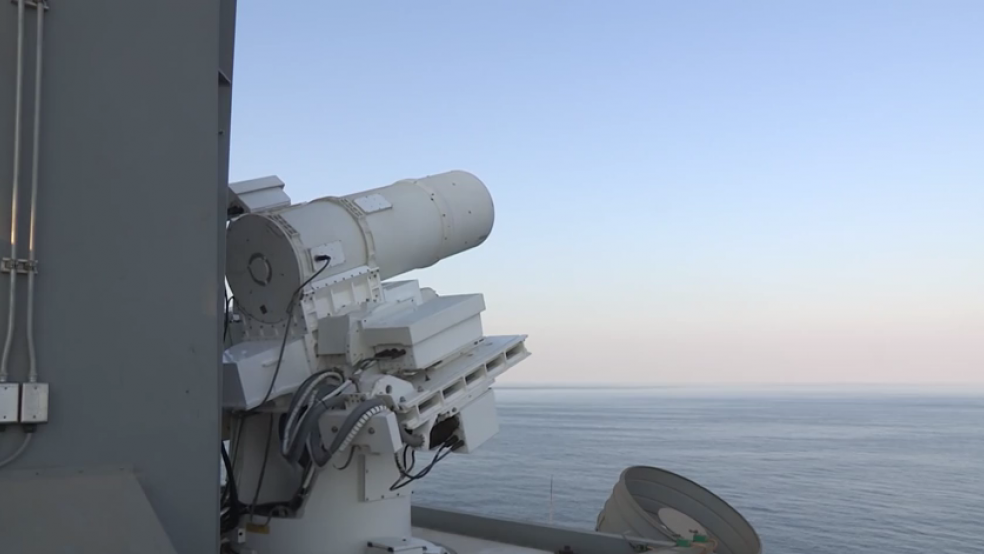It’s a warm November day in the Persian Gulf. The radar system of the USS Ponce detects an incoming vessel. An operator aboard the ship, working a controller not dissimilar to a PlayStation 4 handset, takes aim at the target using the Navy’s Laser Weapon System or LaWS high-aperture telescope. He sees a red, rigid-hulled inflatable boat on fast approach. The operator executes the command to fire. No sound emerges from the deck of the Ponce; there is no burst of gunpowder. The laser precisely destroys a three-foot high stack of shells on the red boat but misses entirely a decoy human just a few inches away.
From September to November, sailors aboard the Ponce, currently deployed to the Persian Gulf, tested the LaWS in a variety of drills and simulations. “They use it every day” for training and targeting, the chief of the Office of Naval Research, Rear Adm. Matthew Klunder, told reporters at the Pentagon on Wednesday.
Related: Putin Threatens to Move Nukes into Crimea as Ruble Tumbles
It hasn’t fired on any actual adversaries yet. But in the event that Iran, the Islamic State or some other adversary attempted to attack the Ponce, possibly with a drone, the ship’s captain has “all the authority” to use the weapon in defense of the vessel, according to Klunder. While the Geneva Convention prohibits the use of lasers directly against human targets, it does allow for the destruction of threatening boats or its components.
That’s one reason why the weapon’s precision is so important. An operator can use it strike a target on a very small craft without hitting the human.
The Navy has been conducting live experiments with high-energy weapons since 2011, when they demonstrated an earlier version of the LaWS that could successfully shoot down drones and sink small boats. The most recent tests surpassed their expectations in how quickly and effectively it tracked and destroyed ever more difficult targets. Klunder, in his briefing, touched on the performance telescope as a particularly key improvement, calling it a sort of “Hubble telescope at sea.”
When pointed at a potential enemy craft in the far distance “we’re picking up a bad person on that ship drinking a soda.” (Klunder could not comment on the actual range.)
Related: 12 Weapons That Changed Everything
The laser, powered by 100 kilowatts of energy, sends a 30-kilowatt blast to the target but can go lower for different effects. More importantly, the current system can fire within a nanometer range of 2 to 3 as opposed to a 10, which was considered cutting-edge just a few years ago. The more focused energy beam detonates targets exponentially quicker than previous versions of the laser.
The weapon can do more than simply blow things up. Because it can fire differing amounts of directed energy at a target, it can also be deployed to blind or “dazzle” an enemy rather than just destroy it. The Navy demonstrated that capability this fall in a face-off with an incoming drone, which the weapon blinded before destroying it. “We knocked an [unmanned aerial vehicle] out of the sky in literally two seconds before it could even catch on fire,” said Klunder. “We not only burned a hole through but destroyed everything inside it.”
Drone hunting is the raison d’etre for the Navy’s laser system. As the price of unmanned aerial vehicles continues to drop, many military scholars are anticipating a near future where hundreds if not thousands of cheaply-armed drones are able to effectively swarm a target. “Low-cost uninhabited systems can be built in large numbers, ‘flooding the zone’ and overwhelming enemy defenses by their sheer numbers,” Center for a New American Security author Paul Scharre writes in this report on the future of swarm robotics.
The laser system offers a counter-drone alternative that, at an estimated cost $1 per shot, is far cheaper than ship to air missiles and far safer for ship crews than gun-powder based traditional ordinance. Klunder put the actual cost at closer to 59 cents per shot, which he contrasted to a standard missile, which can start at $750,000 but reach up to $2 million per unit.
Related: 10 Military Weapons You Won't Believe the Police Have Access To
The beams will get more powerful in the next couple of years. The Office of Naval Research is looking to field a much more powerful, 100 to 150-kilowatt version by 2016. “That will expand the mission set beyond UAVs,” said Klunder. They’ll also find their way onto different types of vehicles. The military also has ongoing plans to deploy laser weapons aboard Army trucks (the High-Energy Laser Mobile Demonstrator) and planes (the Defense Advanced Research Project Agency’s HELLADS laser).
If those systems can prove as accurate and rapid as the Navy’s LaWS system then more and more vehicles, possibly unmanned, will be deployed with lasers in the years ahead.
In the popular G.I. Joe cartoon from the 1980s, the forces of good and evil battle one another on with a variety of laser weapons and seem never capable of hitting anything. Today’s newest laser weapon is terrifyingly accurate.
This article originally appeared in Defense One.
Read more at Defense One:
Can Iran Turn Off Your Lights?
Why Americans Should Care About Foreign Aid
V-22 Osprey Could Get Some Serious Firepower




